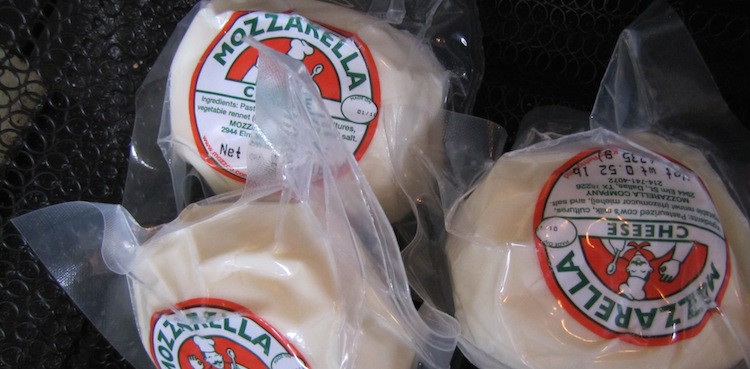
In this blog series intern Briana finds artisan cheesemakers from six regions around the country that represent our cheese nation. Venture along the ride as she goes coast to coast, discovering what makes the U.S. home to great artisan cheese. Read on and find out how you can win a subscription!
Southwest Cheese
What is our vision of the Southwest? For most people it’s cowboys, cacti, wide open roads, and red meat. Not to say this isn’t true, but that’s not all this region has to offer. This region, probably least known for its artisanal cheese, has creameries sprouting up like desert flowers. And they’re making cheese that celebrates the Southwest’s rich, diverse heritage.
In Arizona, Fiore Di Capra, meaning flower of the goat, is making cajeta, a Mexican treat similar in texture and taste to sweetened condensed milk. Made from their own goat’s milk, it’s both tangy and sugary sweet. At Pure Luck Farm and Dairy in Texas, they’re using local Anaheim and Chipotle chilies to flavor their chèvre.
Over the past decade, artisan cheese has started booming in Texas. Owner of Antonelli’s Cheese Shop in Austin, John Antonelli, believes it’s only the beginning of a long love affair with cheese in Texas. They are proud to list 18 Texan creameries on their website, with more surely to come. Yet there is no competition as to which cheesemaker has the longest history with cheesemaking: Paula Lambert of Mozzarella Company.
Belle of the Ball
It’s a classic story of girl meets cheese, girl falls in love with cheese, girl and cheese make a life together. Paula Lambert fell in love with fresh mozzarella while studying in Italy in the ’60s. She had left her hometown of Fort Worth to learn Italian, and there she tasted her first bite of mozzarella in a tomato salad. According to Paula, it was the taste that first attracted her to mozzarella.
“I loved it and I ate it all the time [in Italy]. I came back and no one had ever heard of it here,” said Lambert.
Deciding to extend her stay in Perugia, Italy to learn how to make mozzarella, she befriended Mauro Brufani of Brufani Cheese Factory. For three weeks, she arrived at 6 a.m. every morning to make cheese. Not daunted by being the only woman in the factory, she says it helped to know Italian.
Upon her return to Dallas, Lambert couldn’t find fresh mozzarella anywhere. A light bulb went on, and the Mozzarella Company was born. Being a resourceful and determined woman, she found people to kick-start the business, including people she met in Italy. It was a long and lengthy process, but eight years later in 1982, she opened the Mozzarella Company in the Deep Ellum neighborhood of Dallas.
The most challenging part of opening the Mozzarella Company was selling the cheese. In the early ’80s, no one knew what fresh mozzarella was.
“I had to develop the market because no one had ever heard of it,” said Lambert. So she decided the best way to introduce people to mozzarella was to have it in restaurants. In an interview with Cheese by Hand, Lambert tells the story of how she introduced fresh mozzarella to The Mansion, a well-known restaurant in Dallas. When she brought in the cheese, they asked her if it was made out of flour and gelatin.
Thirty years later, Paula is still a pioneer in the cheese world. Having written two cookbooks on cheese, she also collaborates with Dallas-area chefs to “invent” new types of cheese. Just last year she started her own side company Viaggi Deliziosi, where she leads culinary trips to Italy. All five trips for next year are already booked.
A Sacred Tradition
While it may be called the Mozzarella Company, Lambert and her team make more than just Italian cheese. Being in the Southwest, the flavors of Mexico have managed to seep in. They make a “Mexican mozzarella” called Queso Oaxaca, hand-stretched into long ribbons and rolled up like a ball of yarn. Its mild flavor is similar to that of mozzarella, but with a pleasing chewiness. They also make Chile Caciotta, a Texas version of Monterey Jack seasoned with chilies.
However, their most popular Mexican-inspired cheese is a uniquely Lambert creation. About 15 years ago, she introduced Hoja Santa, an aged goat cheese wrapped in hoja santa leaves (translates to sacred leaves) native to Mexico. The inspiration came from Mexican chef Patricia Quintana, who uses hoja santa leaves to wrap fish and chicken before steaming. After tasting this dish, Lambert knew she had to try this technique on her cheese. Knowing that French cheesemakers wrap cheese in chestnut leaves, she wrapped small chèvres in the hoja santa leaves and let them age two weeks to eight months. Lambert says the cheese only gets better with age. Her invention has proved a wild success, winning top prizes at the American Cheese Society and Good Food Awards.
“The hoja santa leaves permeate the cheese, giving it a beautiful essence. The flavor is of root beer and anise,” Lambert tells me.
Like any good chèvre, it is smooth and creamy, but the hoja santa leaves give it a distinctive herbal taste that doesn’t overpower the light cheese. Lambert recommends heating the cheese for a warm, gooey appetizer.
Having just celebrated her 70th birthday, Lambert shows no signs of slowing down. When I call her, she tells me she’s working on a newsletter and getting cheese ready for the American Cheese Society competition next week. Determined and confident, Lambert is not afraid of a little competition between up-and-coming cheesemakers.
“We’re always trying to do something new,” assures Lambert. And so the story continues.






